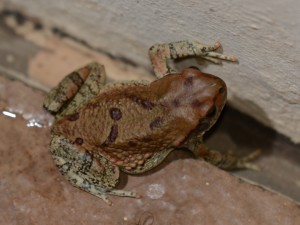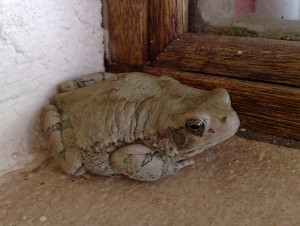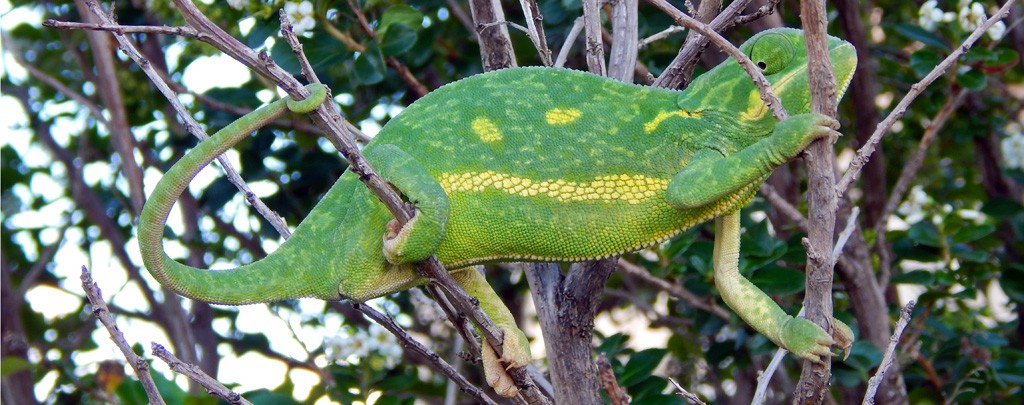Herewith the reptiles (other than snakes) and amphibians observed on our Estate to date.
Click on any of the small pictures to open the full-size photo
Mountain or Leopard Tortoise
(Stychmochelis pardalis – only member of genus Stychmochelis – in past commonly placed in Geochelone). The generic name is from two Greek words Stigma (meaning “mark” or “ point”) and Chelone meaning “tortoise”. The specific name, pardalis is from the Latin word pardus, means “leopard”(referring to its leopard-like spots/markings).
Berg- of Luiperd skilpad (A)
Size: Typically reach a length of about 46cm and a weight of about 18kg. Larger sizes occur in KZN. However larger sizes of 70cm with approximate weight of 54 kg have been recorded. It is the fourth largest species of tortoises in the world.
Age: Normal age reached is between 20 and 40 years. However, records exist of a 150 year old!
Colour and general appearance: The name “leopard tortoise” gives an indication of its colourings. Skin and background cream to yellow and the carapace is marked with darker brown-black splotches, spots or even dashes and stripes. It has a high carapace and sometimes has pyramid shaped scutes. The tortoise does not have teeth and the mouth is a sharp, horn-like, beak enabling it to pluck its food.
The hind legs are very trunk-like in appearance, whilst the front legs are paddle-shaped and pigeon-toed in appearance, with a row of small nails. They can move quite fast with these legs over rocky, or difficult terrain and can climb with ease when necessary. When threatened, it will retract limbs and head into its shell, accompanied by a hissing sound. This is thought to be caused by the lungs squeezing out the air by the retracting movement.
The shell consists of two parts, the outer layer consists of layers of horn-like plate and the inner part is bone-like and is the skeleton. The rounded part is called the carapace and the flat part under the belly is the plastron. The carapace and plastron is attached to the body with a bone-like structure called the “bridge”.
Habitat and food: Semi-arid areas and grasslands (savannas). It is herbivorous and it feeds on a variety of different grasses, wild berries and succulents. They are not supposed to be a hibernating species, however it has been found to hibernate in colder climates under leaves in corners (mostly in captivation and out of their normal habitat). Food is plucked and swallowed without chewing.
Breeding habits: Sexual maturity is reached between 12 – 15 years of age (sometimes earlier in captivation).
After mating, the female will dig a hole in the ground and typically lays a clutch of between 5-18 eggs (more have been recorded). She will then cover up the hole carefully with her hind legs and cover it up further with leaves and other debris, making it hard to find. The incubation period is between 8-14 months – subject to climate and temperature.
The tortoise is a reptile (cold-blooded) and has no motherly instincts. The baby tortoise has what is called an “egg tooth” – a sharp protrusion on its upper beak, which is used to get to the outside world. This egg tooth will eventually wear away as it reaches maturity (some sources think it falls off).
Enemies: It does not have many natural enemies (sometimes wild cats) but their biggest enemy is the human race. Urbanization reduces the size of their habitat. Some people use it as a main source of daily meat and they are often killed just to use the shell to make touristy things such as bracelets and other jewellery etc. Dogs also tend to flip and kill it.
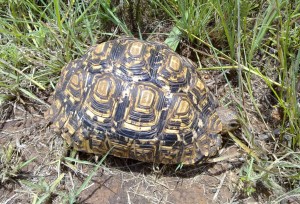
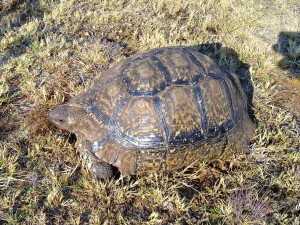
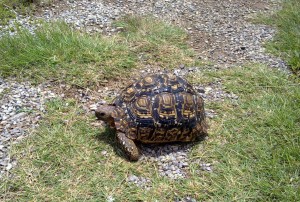
Tropical House Gecko
(Hemidactylus mabouia)
Tropiese huisgeitjie (A)
Size: Maximum length reached 12cm but more commonly about 7cm.
Age: Believed to be about 5 years
Colour and appearance: Varies from dark brown with darker spots/blotches, sometimes yellowish-tan with darker splotches/spots to a greyish colour. It has a fat tail. The large eye does not have a moveable eyelid, but rather a see-through biological contact lens and the pupils are vertical. It has excellent night sight and in the dark the pupil enlarges to cover the whole eye. After a meal it licks the face and eyes to clean it. The skin is soft, velvety and is shed at regular intervals.
When threatened, it can throw off its tail to distract a predator – this process is called autotomy. It will grow back but autotomy cannot take place again. The underside of the feet has cushioned lamellae, with microscopic hair-like” hooks”, that penetrates the smallest unevenness of a surface, thus enabling them to run up straight walls, upside-down on ceilings etc. This movement of grab and let-go is so fast, it can’t be detected by the human eye.
Habitat and food: The tropical house gecko is nocturnal. It is almost entirely found around human habitat, sometimes outdoors, near an outside lights where it awaits prey. It is often found indoors where electric lights once again lure its main source of food – insects! It feeds entirely on insects such as mosquitoes, moths, spiders, cockroaches and small scorpions.
Breeding habits: Early spring seems to be mating season. Females lay 2 hard-shelled eggs and often different females will lay their eggs together in bunches – behind picture frames, underneath tables etc. As soon as it gets warmer the young – much darker in colour, will be seen scattering about. The males are highly territorial. They are very useful in insect-control although, unfortunately, messy and droppings are not easily cleaned.
Enemies: Sometimes birds, bigger lizards, some snakes, human beings, domestic pets.
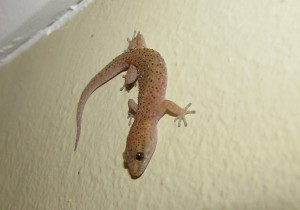
Transvaal Gecko or Transvaal Thick-toed Gecko
(Pachydactylus affinis)
Transvaal geitjie (A)
Size: 6,8cm
Age: No data available – probably the same as most geckos, i.e. +/- 5 years
Colour and appearance: Rounded snout, short thick body and the tail is thick. The toes are short and distinctly broader at the ends. Greyish above, irregularly spotted all over with dark brown; a dark brown streak on each side of the head, passing through the eye; lower parts white. Head covered with minute granules, which are larger on the snout. The immature is more finely spotted. The large eyes set within the chubby head indicates it is mostly nocturnal.
Habitat and food: Spends days mostly under stones, rocks or logs. It hunts for moths, termites, beetles and other insects. Sometimes seen in homes where it will be hunting for insects.
Breeding habits: Lays two hard-shelled eggs in early spring.
Enemies: Sometimes birds, bigger lizards, some snakes and frogs and domesticated pets as well as the use of pesticides by humans.
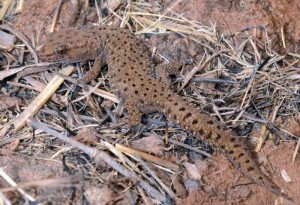
Flap Neck Chameleon
(Chamaeleo dilepis)
Trapsuutjies/Verkeleurmannetjie (A)
Of the 19 recognised chameleon species in South Africa, the Flap Neck Chameleon is the one most commonly found in our area.
Size: Average 30-40 cm
Age: Can reach to about 5 years of age, sometimes older.
Colour and Appearance: This interesting reptile has a large, rounded head, conical eyes and curled tail. Adults are predominantly green in colour but change colour to blend with background and/or when stressed or in danger. They are distinguished by their long tongues, their swaying gait and their separately moving, protruding eyes. They are active during the day.
Chameleons have the most distinctive eyes of any reptile. The upper and lower eyelids are joined, with only a pinhole large enough for the pupil to see through. They can rotate and focus separately to observe two different objects simultaneously; their eyes move independently from each other. Prey is located using monocular depth perception. Chameleons have very good eyesight for reptiles, letting them see small insects from a long distance. The eyes give them a full 360-degree arc of vision around their bodies.
Something else that is very interesting about chameleons are their feet. On each foot, the five clearly distinguished toes are grouped into two fascicles. The toes in each fascicle are bound into a flattened group of either two or three, giving each foot a tongs-like appearance. On the front feet, the outer, lateral group contains two toes, whereas the inner, medial group contains three. On the rear feet, this arrangement is reversed, the medial group containing two toes and the lateral group three. These specialized feet allow chameleons to grip tightly onto narrow or rough branches. Furthermore, each toe is equipped with a sharp claw to afford a grip on surfaces such as bark when climbing.
Habitat and food: Chameleons are arboreal (lives mostly in trees or shrubs) where it sits quietly awaiting prey. It can, however move about on the ground when locating to a new bush, or when the female wants to lay her eggs. When prey is spotted the tongue is projected in a swift movement to catch it. Prey can be reached in 0,07 seconds! Chameleons are primarily insectivorous.
Breeding Habits: They are oviparous. Interestingly, the dwarf chameleon found in South Africa gives birth to live young. Mating is usually during summer months – December being peak period for foraging and mating, and egg laying between February and March. The female will go down to ground level and carefully select a spot to dig a hole and will lay her eggs in it. A clutch of up to 60 eggs can be laid! Incubation is between 9 and 12 months – depending on size and species of chameleon. The tiny new-borns are immediately able to fend for themselves.
Enemies: Snakes, birds – especially when moving on the ground for egg laying or to locate to a new area. This wonderful animal used to be plentiful in urban gardens but are becoming scarcer because of things like pesticide use, they get run over by cars when moving in a road, electric fences kill them, cats and dogs kill them and many people kill them because of superstitious beliefs.
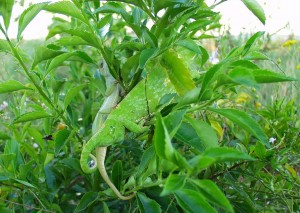
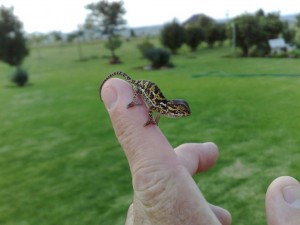
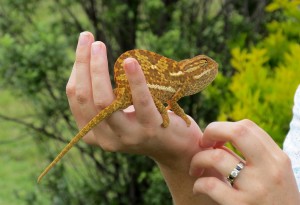
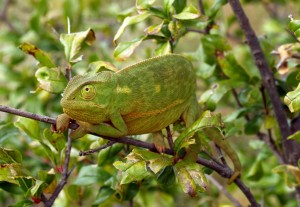
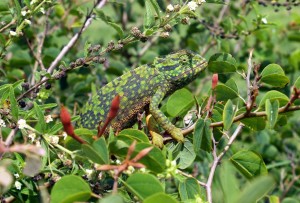
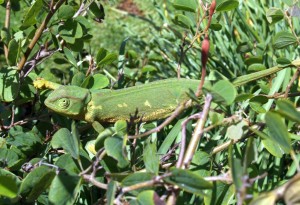
Speckled Rock Skink
(Trachyleois punctatissima)
Gespikkeld rotsskink (A)
Size: 18-2 cm
Colour and appearance: This sink is dark grey-brown in colour with two golden brown stripes that run lengthwise on either side of the spine. The underside is dirty white or pale grey. Both sexes grow to a length of about 19cm.
Habitat and food: Wide variety of habitats and may be found on garden walls, walls of houses or on paving around houses. Insect prey is captured after a chase.
Breeding Habits: Southern populations give birth to a single litter of 3 – 9 babies in summer. Reproduction may occur throughout the year in northern populations. Growth is relatively fast and sexual maturity is reached in 15 – 18 months.
Enemies: Snakes, birds, domestic cats and dogs, use of pesticides.
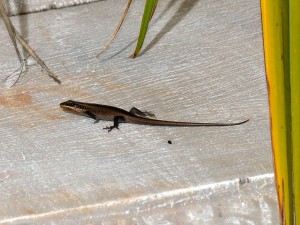

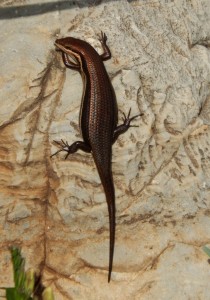
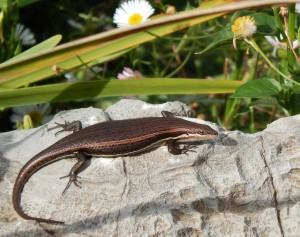
Cape Skink, or Cape Threelined Skink
(Trachylepis capensis)
Kaapse skink (A)
Size: About 25cm
Colour and appearance: Chubby pale-bodied, with dark brown to black spots or short bars between the stripes (running alongside the body and extending onto lower flanks and a long tapering tail. Three off-white stripes run the length of the greyish-buff body. Underbelly is off-white.
Habitat and food: The Cape skink is probably the best-known lizard in South Africa as it is common in gardens and has an extensive range in South Africa. Their habitat is varied and occurs in dry Karoo veld, moist savanna, dry savanna, moist coastal bush, etc. Like most skinks it is ground-living and hides in tunnels it digs beneath bushes boulders and rocks as well as dead aloe stems. It is an active forager that hunts for larger insects.
Breeding: It is a live-bearing species, giving birth in late summer to between 5 and 18 babies. However, there are reports of them laying eggs from Pretoria and Port Elizabeth areas.
Enemies: Birds, some snakes and domestic pets and the use of pesticides.
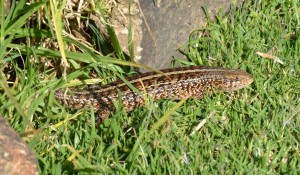
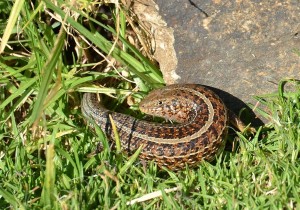
Common River Frog
(Amietia angolensis)
Gewone rivierpadda (A)
Length: Maximum length 90mm; the female is smaller in size.
Age: Not known. Depends on predators and area.
Colour and appearance: Various shades of brown or green, scattered with dark blotches. Streamlined body with pointed snout. The skin is smooth with longitudinal, slightly elevated broken skin ridges. Its underside is smooth and white with the throat sometimes marbled grey, black or brown. Their feet are long and extensively webbed. Two phalanges of the longest toe are free from webbing. The legs are long and very powerful. The tympanum (eardrum) is visible and slightly larger than half the diameter of the eye.
During breeding season the male has a dark swollen nuptial pad on its thumb. Their call is a series of rapid klik-klik-klik (like a rattle) followed by a keroip croak. Males call during day as well as night from either partially concealed, or exposed sites near water’s edge.
Habitat and food: It frequently inhabits garden ponds but in the wild the habitat is on the banks of slow-flowing streams, wetland areas in grassland, fresh water marshes, canals and ditches, savanna and forest fringes or other permanent bodies of water. The adults spend the day floating amongst vegetation or basking on rocks above the water.
It consumes large numbers of flying and crawling insects such as flies, mosquitoes, locusts etc.
Breeding habits: Breeding takes place in shallow water along the edges of pools, dams, streams and slow-flowing rivers. Eggs, in clutches of 400-500 are laid in shallow water. The large tadpoles are brown with some flecking and can reach a total length of 80 mm or bigger.
Enemies: Otters, large birds and snakes. This frog is not threatened or on any endangered lists and has a widespread habitat. However, localized threats include acid pollution from old gold mine dumps.
- Note: Batrachochytrium dendrobatidis (Bd) – a chytrid fungus that was first reported as the cause of chytridiomycosis – an often deadly and highly infectious disease of amphibians has been found in frogs in SA. This fungus is found on all continents except Antarctica and plays a large role in global amphibian declines.

Platanna or Clawed Frog
(Xenopus laevis)
Platanna (A)
General:
Of all frog species, the Xenopus, (four species have been identified in South Africa) is the most interesting. The name Xenopus is derived from a combination of the Greek words xenos, meaning “strange” and pous meaning “foot” and refers to the strange appearance of the clawed foot. The word laevis means “smooth”, referring to the appearance of the skin. The genus is truly African, although there are known feral populations which exist due to export of the species for the now, outdated, pregnancy tests.
Xenopus laevis has been kept as pets and also used in research for decades. In the early 1930’s two South African scientists discovered that by injecting the urine of a pregnant woman subcutaneously (just under the skin) of a female Platanna, she would spawn. This research resulted in the first commercially available pregnancy test and enormous numbers of the frog was exported all over the world for this purpose. Until more sophisticated chemical methods became available in the 1960’s, the “frog test” was the standard and only available pregnancy test. Xenopus embryos and eggs are a popular model system for a wide variety of biological studies.
The Platanna is widely used because of its powerful combination of experimental tractability and close evolutionary relationship with humans – at least compared to many other model organisms. For instance the X. laevis have been used by Roger Wolcott Sperry in his famous experiments describing the development of the visual system. All modes of Xenopus research (embryos, cell-free, extracts, etc) are commonly used in direct studies of human disease genes. The Xenopus laevis is the best-known species in the Xenopus genus and is commonly studied as a model organism for developmental biology, cell biology, toxicology, and neuroscience.
So, our humble platanna is world famous in the medical research field, and, in fact, in the Hebrew language, the genus name literally means “Medical frog”!
Platannas have no vocal cords or vocal sacks and their method of calling is unique. Their sound is produced by the movement of modified laryngeal cartilage elements, rubbing against each other.
The clawed frogs are the only amphibians to have actual (though small) claws! The Platanna has no tongue (or rather it is completely attached to the floor of the mouth) or teeth, no moveable eyelids and no tympanum (eardrum). They have a conspicuous lateral line (stitch-like in appearance) along its side that is used to detect vibrations and movement under water and this is used to detect food.
The platanna is totally aquatic and only emerge from the water when migrating to fresh bodies of water in times of drought. Though they are able to take up oxygen through its skin, they have to break the surface of the water in order to breathe. This they do quickly, while gulping for air.
It is popularly sold as pets and is frequently mislabelled as African Dwarf Frogs in pet stores. However these are characteristic differences:
- Dwarf frogs have four webbed feet. African Clawed Frogs have webbed hind feet while their front feet have autonomous digits.
- African Dwarf Frogs have eyes positioned on the side of their head, while African Clawed Frogs have eyes on the top of their heads
- African Clawed Frogs have curved, flat snouts. The snout of an African Dwarf Frog is pointed.
Facts of the Common Platanna, which is the one found in our area:
Maximum length reached: 14.7cm on average about 13cm. The female is about 20% larger than the male and in the wild they are larger in size than in captivity.
Age: The average life span of these frogs ranges from 5-15 years with some individuals recorded to live to between 20-25 years of age in captivity.
Colour and appearance: Brown to grey with irregular dark blotches. It has a rounded snout and the eyes face upwards. Underside is usually creamy-yellow to grey and the skin is smooth. The forelimbs have hands with four, thin, long toes, while the hind limbs are powerful and large and the feet are fully webbed. The female appears far plumper, with hip-like bulges above their rear legs (where their eggs are internally located). They use their hands to guide food into their mouths and they also use the claws on their feet to tear pieces of large food. The call is a loud undulating snoring sound, produced while fully submerged. Both male and females call and during breeding season, the males will call both during the day as well as during the night.
Habitat and food: Their diet consists of worms, water bugs, spiders and small fish. Xenopus laevis are scavengers and will also eat almost anything living, dying or dead and any type of organic waste. They live strictly in aquatic habitats (although they can migrate to fresh water sources or in drought situations) and can be found in any form of wetland be it natural or man-made.
Breeding habits: Platannas reach sexual maturity between 1-2 years of age. They reproduce by laying eggs and are prolific egg-layers. During breeding season, the males develop ridge-like nuptial pads (black in colour) on the fingers to aid in grasping the female. The female’s cloacal folds are more swollen than those of the male during breeding season. The frogs’ mating embrace is inguinal, meaning that the male grasps the female around her waist!
Enemies: Because they are mostly submerged, they are safe from most predators. The heron is its most common threat. When migrating to another water source, they are prey to snakes and birds of prey.
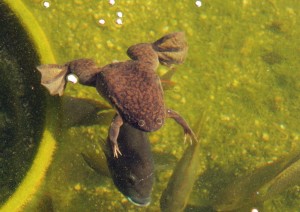
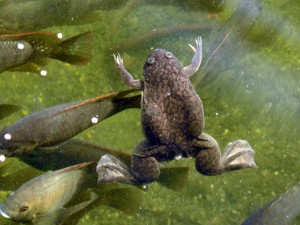
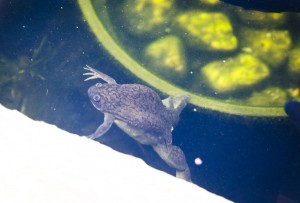
Bubbling Kassina
(Kassina senegalensis)
Borrelvleipadda (A)
Size: maximum 4.9 cm in South Africa and both males and females are the same size
Colour and appearance: The body is bullet-shaped and smooth with protruding eyes. Bold black vertebral black bands on the back and broken paravertebral bands on a yellow, olive or silver-beige background. The underside is off-white and smooth in the front part and granular hind part. Toes a re whitish and slightly webbed and do not have terminal discs or bulbs. Because of their small hind legs, they are characterized by preferring a distinctive “walking” with the back legs instead of the more traditional hopping.
The call is a short boip on a rising note, with long intervals between calls. When a male calls, he triggers calls from other neighbours resulting in a ‘bubbling’ effect. The calling begins late afternoon, well away from a water source and as it gets darker, it moves closer to the water, eventually occupying semi-concealed spots on the edge of the water. It is a shy and not often seen frog. When a human nears a calling frog to find it, the frog stops calling and sits still. When the frog is not moving, its colour and pattern helps it to blend into the grass and make it very difficult to spot.
Habitat and food: These frogs are terrestrial, which means they live along the ground. For much of the year, they are usually found in grassy areas, grasslands around vleis, and breeds in temporary and permanent water bodies including marshes, pans, dams and ponds. It can be found in agricultural areas. Food consists of a variety of arthropods, including termites, caterpillars, ants, flies and spiders.
Breeding habits: Females will approach calling males on dry terrain and the pair will make its way to water with a good deal of vegetation growing inside it. The female, whilst grasping onto vegetation will deposit between 100-500 eggs. It will be released singly (sometimes in groups of about 20) and it will drop to the bottom or become attached to the vegetation. Tadpoles are large with high tail fins. They hatch within 5-6 days, but metamorphosis may take 2-3 months.
Enemies: Snakes and birds-of-prey.
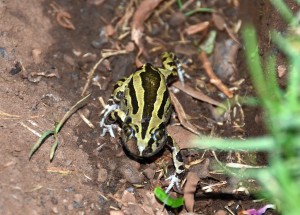
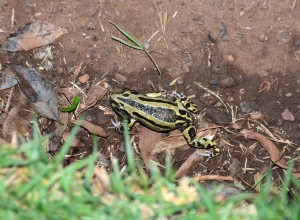
Guttural Toad
(Amietophrynus gutturalis)
Gorrelskurwepadda (A)
Size: Maxim 12cm
Colour and appearance: It has a thick-set and robust body and a blunt snout. The body is covered with wart-like elevations. Between the eyes, a pale cross is formed by two sets of dark patches. A noticeable identification of this frog, is the red line, or infusion on the hind legs. The body is light to dark brown with dark paravertebral patches. Prominent parotid glands can be found on the neck behind each eye. Toes are webbed only very slightly at the base. The male feet has distinct dark nuptial pads in breeding season.
The call is a deep guttural rasping sound. Males call throughout the year (from early spring to late summer it becomes more intense and louder) from either exposed or partially concealed sites close to water.
Habitat and food: They are very common in suburban gardens and can often be spotted at night where an outside light attracts insects. Also found around vlei areas, dams ponds and permanent or semi-permanent bodies of water near grassland, thicket or savanna.
A. gutturalis’ prey include a wide range of insects, spiders and centipedes. On nights when termites fly this frog can be found gorging itself! Adults will eat just about anything that moves and will fit into their mouths, although most of their diet consists of insects. A very good pesticide controller!
Breeding habits: Breeding takes place in small permanent water bodies, and in areas where there are no permanent water bodies, the breeding will begin with the first heavy rains. Males call from inside breeding habitats, both permanent and temporary pools. Females are attracted to the calls and when approaching they are quickly grasped by males. Many males may try to grasp one female forming large balls of animals. Eggs are laid in long strings (bead-like) that have many thousands of eggs. Small dark tadpoles with bright specks emerge after 2 – 3 days and reach metamorphosis after 75 days. They have toxins which make them unpalatable to birds and mammals but are eaten by clawed frogs and aquatic insects.
Enemies: When attacked by predators, B. gutturalis exudes a toxin from the parotid glands, which contains epinephrine that can be fatal to small mammals. Despite this, they are still prey on by the night adder and of course the Rinkhals love them.
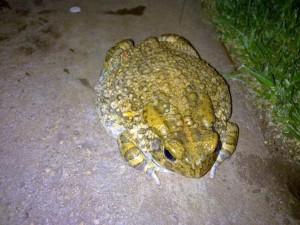
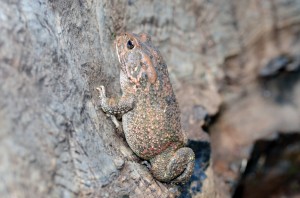
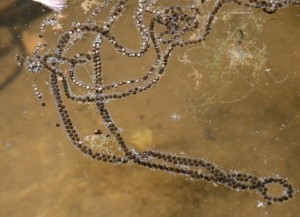
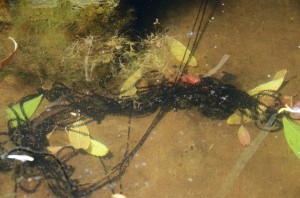
Natal Sand Frog
(Tomopterna natalensis)
Natalse Sandpadda (A)
Size: Maximum size of 4cm.
Colour and Appearance: The head is more pointed than other species in this genus. A pair of dark glandular elevations usually present in the middle of the back. The skin on the back is smooth to slightly granular.
The call is a series of high-pitched penetrating “tut-tut-tut” notes. Males call from exposed positions near the water’s edge, on bare sand, mud or rock.
- Listen to the sound clip of the Natal Sand Frog and the Guttural Toad, recorded by Garfield Krige on his property at SCE129!
- Natal Sand Frog and Guttural Toad
- (The high-pitched penetrating “tut-tut-tut” sound is that of the Natal Sand Frog, while the deep guttural rasping sound is that of the Guttural Toad)
Habitat and food: It lives in grassland and savannah, and it can also be found in agricultural habitats. It breeds in shallow temporary, semi-permanent and permanent streams, furrows or vleis, also in still water (but it favours slow-flowing water). Feeds mainly on insects.
Breeding habits: Breeding takes place in streams, rivers or other places where water flows slowly, but also, sometimes in standing water. Breeding begins after the first rains, continuing into midsummer. The eggs are usually laid singly or in small groups, in running water.
Enemies: Mainly snakes.
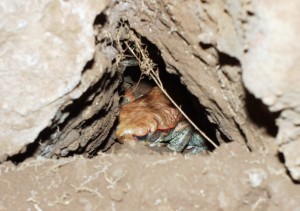
Red Toad
(Schismaderma carens)
Rooiskurwepadda (A)
Size: Maximum 9.2cm
Colour and appearance: The body is leathery in appearance and lacks paratoid glands or the large skin elevations that appear in other toads. Despite the absence of the paratoidal glands, it defends itself like other toads by secreting a toxic fluid from the dorsal skin when in danger. A distinct dorsolateral glandular ridge runs from above the tympanum to the hind leg. The underside of the ridge is darker in colour. The tympanum is large and round. Breeding ales have vocal sacks as well as nuptial pads on their first three fingers in order to grab the female (amplexus). Another characteristic is the two darker spots on the lower back as well as a pair of markings on its shoulders. The upper side is red in colour, but a light coloured variation exists. Adults shed their skins at 4-day intervals. Calling occurs usually in midsummer. Males call at night and on overcast days. Calls are usually made while floating in the shallow water with outstretched limbs and the sound is a deep ‘whooop’ sound.
- Listen to the sound of the Red Toad
- Red toad
Habitat and food: It occurs mainly in grassland and Woodstock savanna, but is also found around farms and human settlement. It hibernates at a considerable distance away from water. They often hide under tree trunks but are competent climbers and can often be found under the eves of houses or similar retreats. They often enter houses and may be found hiding in unusual places like corners of cupboards Feed mainly on insects.
Breeding habits: Breeding is stimulated by heavy rainfall. It breeds in fairly deep water. Breeding occurs in summer, usually at the peak of the rainy season. Amplectant pairs deposit double strings of about 20 000 eggs or more, threading it among underwater vegetation.
The tadpoles are unique morphologically due to a horseshoe-shaped flap of skin on the head. Development takes 37-52 days to complete metamorphosis.
Enemies: Dragonfly nymphs and the hamerkop may prey upon the tadpoles, while the adults are preyed upon by snakes and owls.
